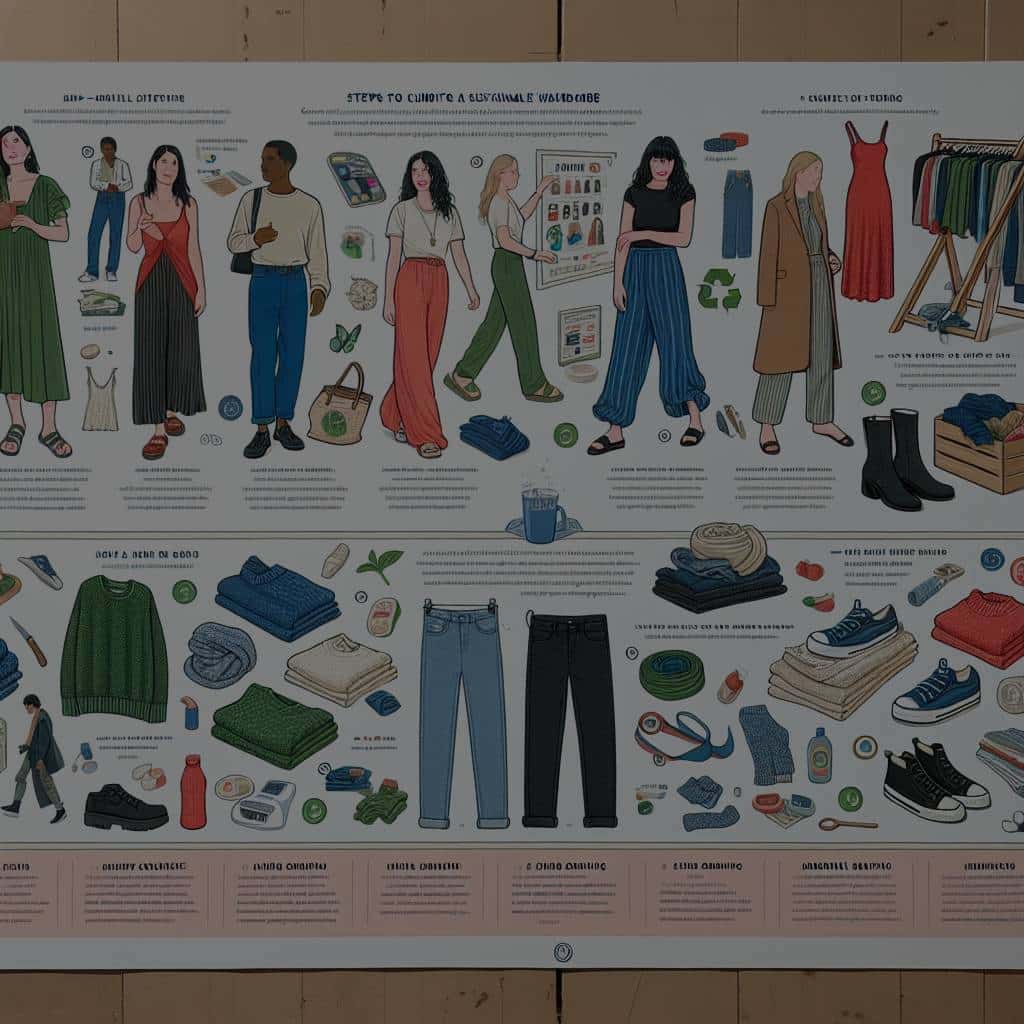In a world where the demand for fast, low-cost fashion is becoming seemingly insurmountable, the effects on the environment are startling. More than ever, we need to pay attention to our clothing habits. The industry has a significant impact on our planet, and it’s high time we take a proactive approach towards sustainability. The way forward is to choose sustainable clothing, and a major part of that involves curating a wardrobe that’s eco-friendly and minimizes fashion waste. But how exactly can we do this?
Exploring the Impact of the Fashion Industry
To better understand the importance of a sustainable wardrobe, let’s first delve into the very real effects of the fashion industry on the environment. The environmental impact of fashion is staggering. From the production of raw materials to the disposal of clothes, every stage adds up to a significant burden on our planet.
Additional reading : Discover monaco's luxury living with homes real estate agency
The fashion industry is one of the largest polluters in the world. A single piece of clothing can have a massive environmental footprint, from the water and energy used in production to the chemicals and waste generated. For instance, it takes about 2,720 liters of water, equivalent to what a person drinks in 2.5 years, to make just one cotton shirt. Moreover, fashion production releases about 10% of global carbon emissions, more than international flights and maritime shipping combined.
Fast fashion, with its rapid turnaround of clothing styles and low quality, plays a major role in environmental degradation. These low-cost clothes are often discarded after a few wears, contributing to the immense amount of waste. In fact, every second, the equivalent of one garbage truck of textiles is landfilled or burned.
Also read : Which kitchen accessories shop should you choose in Canada ?
Sustainable Fashion: A Viable Solution
In response to the damaging practices of the fast fashion industry, a new wave of eco-friendly brands has emerged. These brands prioritize sustainable materials and processes, aiming to reduce the negative environmental and social impacts of clothing production.
Sustainable fashion brands use materials like organic cotton, recycled fibers, and other eco-friendly materials, reducing the water and energy needed in production. They also prioritize fair labor practices and ensure that their workers are paid a living wage. By choosing these brands, you’re not only making an environmentally conscious decision, but also a socially responsible one.
However, sustainable fashion goes beyond just the brands we support. It also involves how we, as consumers, interact with our clothes. Minimizing waste and extending the lifespan of our clothing pieces play a key role in sustainable fashion.
Curating a Sustainable Wardrobe
As we become more aware of the impact of our fashion choices, many of us are seeking ways to curate a more sustainable wardrobe. But where should we start?
First and foremost, take stock of what’s already in your wardrobe. Identify the pieces you love and wear often, and make a commitment to wearing them more. The most sustainable clothes are the ones you already own. Don’t be afraid to repeat outfits – after all, it’s far better for the environment.
Invest in quality, versatile pieces that will last. High-quality clothes may have a higher upfront cost, but they often last significantly longer than cheap, fast fashion items. Choose timeless styles over trendy pieces to ensure your clothes won’t go out of fashion quickly.
Furthermore, consider the materials your clothes are made from. Opt for eco-friendly materials like organic cotton, hemp, linen, and recycled fibers. These materials generally have a lower environmental impact than conventional materials like synthetic fibers, which are derived from fossil fuels and shed microplastics when washed.
Minimizing Fashion Waste
Part of having a sustainable wardrobe involves minimizing fashion waste. This not only means reducing the amount of clothes we buy but also disposing of old clothes responsibly.
Instead of throwing away old clothes, consider other options. Clothes in good condition can be resold or donated, giving them a new life. Clothes that are too worn to be used can often be recycled or composted, depending on the material.
Additionally, consider clothes swapping or renting. These practices not only minimize waste but also offer a way to refresh your wardrobe without buying new clothes.
In the end, curating a sustainable wardrobe is not about restricting your fashion choices, but about making more informed and conscious decisions. It’s about understanding the impact of your fashion choices and taking steps to minimize it. It’s a journey that will not only benefit the environment but also lead to a more thoughtful and satisfying relationship with your clothes.
Embracing Slow Fashion Habits
The concept of slow fashion encourages us to take a step back from our consumption habits and focus on quality over quantity. It prioritizes ethical manufacturing processes, sustainable materials, and long-lasting garments over fast, disposable fashion. By embracing slow fashion, we can make a significant difference in reducing the environmental impact of the fashion industry.
One way to adopt slow fashion habits is by buying less and choosing well. This means opting for high-quality garments that are made to last and can withstand repeated wear and washing. It also means selecting clothes that are versatile and can be mixed and matched with other pieces in your wardrobe, creating more outfit options with fewer items.
Another key aspect of slow fashion is supporting sustainable brands. These brands prioritize ethical and environmental considerations throughout their supply chain, from sourcing sustainable materials like organic cotton and recycled fibers, to ensuring fair labor practices at every stage of production.
Moreover, slow fashion advocates for the repair and care of the clothes we already own to extend their lifespan. This can involve mending damaged items, taking good care of your clothes, and even upcycling old garments into something new and unique.
Lastly, the slow fashion movement supports buying second hand. Whether it’s through thrift stores, consignment shops, or online resale platforms, purchasing pre-loved clothes can give them a second life and prevent them from ending up in landfill sites.
The Role of Circular Economy in Fashion Sustainability
The concept of a circular economy is another important strategy to minimize fashion waste and create a more sustainable wardrobe. Unlike a linear economy, which follows a ‘take-make-dispose’ model, a circular economy aims to keep resources in use for as long as possible, extract the maximum value from them while in use, and then recover and regenerate products and materials at the end of each service life.
In the fashion industry, a circular economy can involve practices such as recycling old clothes into new ones, developing clothes from sustainable and recyclable materials, and promoting the rental or sharing of clothes. All these practices help to extend the life cycle of our clothes and reduce the need for new resources.
Additionally, consumers play an essential role in promoting a circular economy in the fashion industry. We can contribute by buying less and choosing second-hand or recycled clothes, repairing our clothes, swapping clothes with friends, and responsibly disposing of our unwanted clothes.
Conclusion
Building a sustainable wardrobe and minimizing fashion waste are both achievable and necessary endeavors. While the fashion industry’s environmental impact is significant, we as consumers can drive change through our choices and actions. By supporting sustainable brands, embracing the principles of slow fashion, and promoting a circular economy, we can help to reduce the industry’s environmental footprint.
Remember, it’s not about having a perfect, entirely sustainable wardrobe overnight. It’s about making gradual changes towards more sustainable practices and becoming more conscious of our fashion habits. Every step we take towards a more sustainable wardrobe, no matter how small, makes a difference.
Having a sustainable wardrobe not only helps protect our planet, it also allows us to appreciate and value our clothes longer. Through more mindful consumption, we can discover a more fulfilling and sustainable relationship with fashion.






